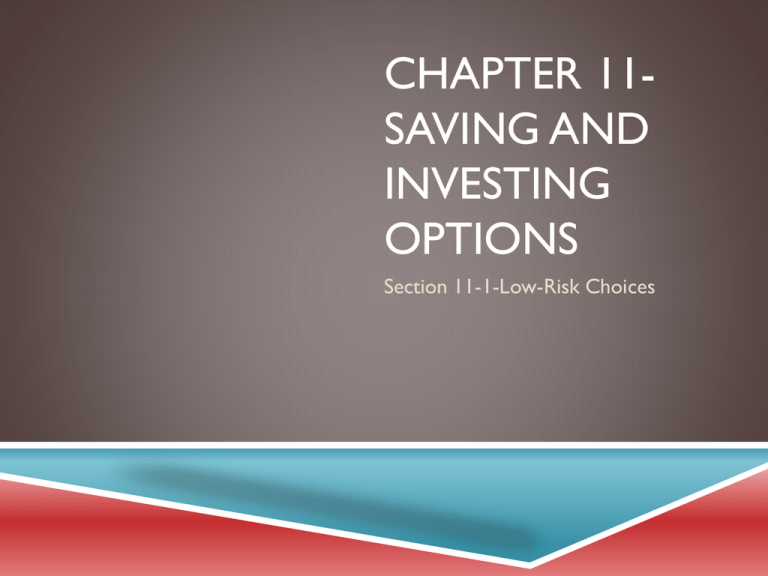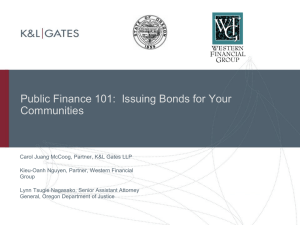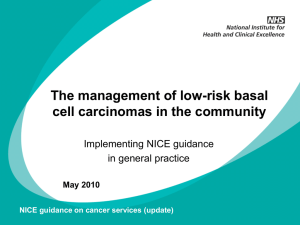Chapter 11- Saving and Investing Options
advertisement

CHAPTER 11SAVING AND INVESTING OPTIONS Section 11-1-Low-Risk Choices LOW-RISK SAVINGS OPTIONS What is Savings? Savings is money set aside for future needs Characteristics of Savings: It should be liquid-meaning it can be quickly changed into cash A checking or savings account in a bank with no restrictions on withdrawals It should be safe-FDIC insured Illiquid investments-cannot be converted to cash quickly or without penalty SAVINGS ACCOUNTS A low-risk, liquid savings option FDIC insured Usually don’t have withdraw penalties Usually pays a low rate of interest Considered a safe place to put your money MONEY MARKET ACCOUNTS Low-risk, liquid savings option Money Market Deposit Account Large deposit required FDIC insured Liquid Higher interest rate than savings account Money Market Fund Account NOT FDIC insured A low-risk mutual fund that invests in low-risk securities CERTIFICATES OF DEPOSIT Money set aside for a specific length of time at a fixed interest rate Must invest a certain amount for a specific length of time NOT a liquid investment Heavy penalty if you withdraw funds early Early-withdrawal penalty-a fee imposed to discourage depositors from withdrawing the money before the stated time period Low-risk investment Inflation risk is the only risk Some CDs can be “borrowed against” Can get a loan because you have a CD with a bank CD is then “pledged” until it matures or the loan is paid off LIFE INSURANCE SAVINGS PLANS Permanent life insurance policy Savings feature that gains cash value Low rate of return Illiquid investment NOT FDIC insured BROKERAGE ACCOUNTS An account with an investment company Clearing account-used to buy and sell investments Money taken from account to buy investments Money returned when investments are sold Low rate of return NOT FDIC insured Liquid investment LOW-RISK INVESTMENT OPTIONS Usually pay a lower rate of return Liquid BONDS A bond is a loan that a buyer makes to a bond issuer. Face Value Bonds-the amount that the bondholder will be repaid on the maturity date (date the borrowed money must be repaid) Discount Bond-a bond that is sold for less than its face value Premium Bond-a bond that is sold for more than its face value CORPORATE BONDS Issued by corporations to raise money Bonds are a form of borrowing for a company Coupon rate-the fixed rate of interest that is paid semiannually for the life of a bond Callable bond-a bond with a clause that allows the issuer to repay the bond early Convertible bond-a bond that can be exchanged for shares of common stock at the option of the bondholder Zero Coupon Bond-A discount corporate bond that does not provide the typical semiannual interest payments GOVERNMENT BONDS A tax-shelter investment-allows you to legally avoid or reduce income taxes Types of investments: Series EE Savings Bonds: safe, low-risk, sold for half of the face value, penalty if redeemed before five years, tax free earnings if used for educational expenses I Savings Bonds: low-risk, liquid savings option, penalty if redeemed before five years, tax free earnings if used for educational expenses GOVERNMENT SECURITIES Treasury Bills (T-Bills): discounted from face value, no minimum ownership term required Treasury Notes (T-Notes): minimum $100 purchase required, 30-year term, no minimum ownership term required Treasury Bonds: Minimum purchase of $100, 30-year term. Pays interest every six months until maturity, no minimum ownership term required Treasury Inflation-Protected Securities (TIPS) Guaranteed to keep pace with the rate to inflation. Face value increases with the rate of inflation. Interest paid twice yearly, at a fixed rate, minimum purchase is $100, no minimum ownership term STATE AND LOCAL SECURITIES Municipal bonds: issued by states, counties, cities and towns Used to pay for projects, such as roads or public buildings Tax-exempt earnings Low-risk investment ANNUITIES Annuity: a contract purchased from an insurance company that guarantees a series of regular monthly payments for a set time. To purchase an annuity: A monthly payment is paid into an account for a set number of years At the end of the set number of payments, the account starts paying you monthly payments Usually, low-risk Not insured Tax-deferred








